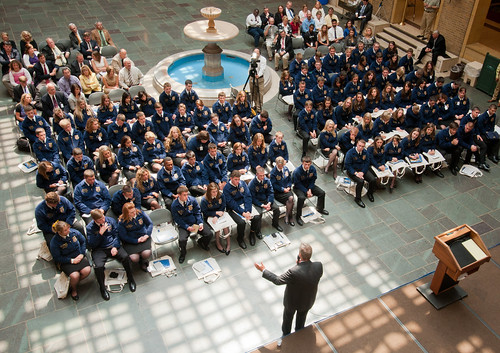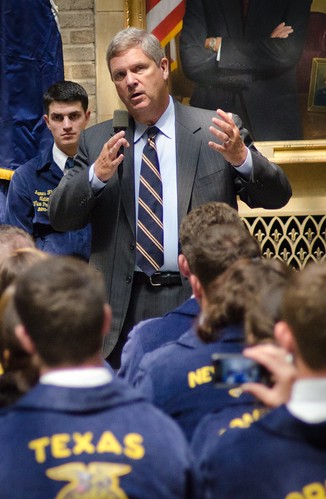
The economy its affect on agriculture was a common theme among leaders of the (former) Future Farmers of America who met with Agriculture Secretary Tom Vilsack as part of the National FFA State President’s Conference.
Yesterday the Secretary spoke to more than 100 FFA leaders at USDA headquarters in Washington about the challenges facing agriculture and the importance of the 2012 Farm Bill. But he didn’t speak long. Instead, he gave the floor to the students to get their views and opinions.
Referring to his briefing for his event with the FFA group, Vilsack said there was one sentence that struck him.
“It said their opinions and ideas matter,” said Vilsack. “If they matter, then instead of me talking to them, I will have them talk to me.”
The group of FFA presidents and vice-presidents asked questions about agriculture and the cattle industry, immigration, what the future holds for young farmers and how more resources can be put at the disposal of organic farmers.
Vilsack said the ultimate answer to many of these questions will be in the passing of the 2012 Farm Bill. “Together we are less than 1 percent (of America’s population). The challenge is to remind the other 99 percent of our importance and to use the next Farm Bill to build a stronger ag economy.”
He acknowledged that difficult fiscal times mean there may be fewer programs and less money, yet there needs to be a way in the next farm bill to grow the number of young farmers “The challenge is to create a program where young people can earn sweat equity,” said Vilsack. By providing incentives to older farmers that allow younger farmers a chance to purchase their land while working the land.
Vilsack also encouraged the young people to find creative ways to make things work. “With fewer programs and less money there is more flexibility for partnering,” he said, suggesting that private businesses could partner with producers and farmers markets to provide funding.

“He gave us a lot of insight into what is happening now,” said Chelsea Daugherty, 18, from Kentucky. “It was truly inspiring and I enjoyed that he gave us an opportunity to communicate with him.”
Adam Heggelund, 19, from Montana agreed. “He informed us and opened us up to a lot of issues and we are grateful,” he said.
The Secretary has demonstrated strong support for the mission of the National FFA, and earlier this year signed a Memorandum of Understanding to deepen USDA’s involvement with FFA and to supplement its mission. He also challenged the National FFA Officer Team to think about their vision for the future of American agriculture and make recommendations to him directly about what they would like to see in the next Farm Bill.
The Secretary noted that USDA is working with partners to support young, motivated entrepreneurs who are looking past traditional ways of bringing products to market. Through the efforts of the Farm Credit Council and with funding provided with a grant from USDA's Risk Management Agency, the Secretary said a new Internet tool has been developed to assist the growing numbers of direct-market farms and ranches and also the lenders, accountants and other businesses who work with them. Titled the "Field Guide to the New American Foodshed" it was inspired by the "Know Your Farmer, Know Your Food" initiative. The Guide describes the business relationships between farms, processors, distributors, and business advisors and includes case studies showing how farms and ranches are utilizing a growing number of regional food marketing channels.
